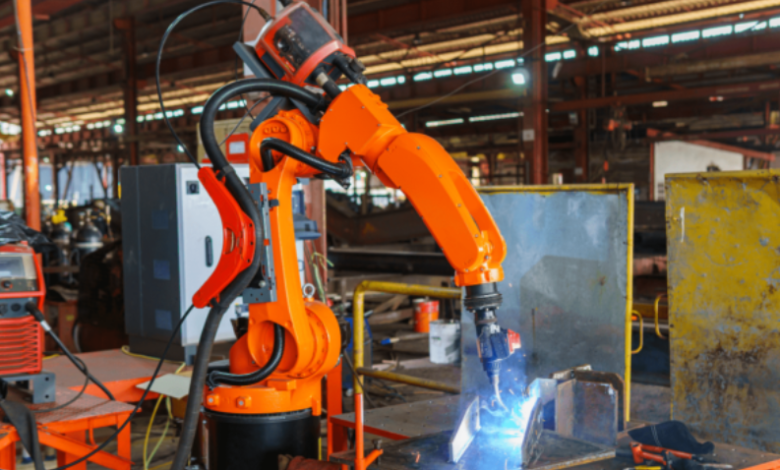Is a Robotic Welding Arm Worth the Investment? Cost and ROI Insights

Today, factories rely on automation more. With higher labor costs and the need for faster, more accurate, and reliable production, companies are turning to smarter tools to stay competitive. A robotic welding arm is one of the most useful solutions. It can do jobs that once needed skilled workers, working faster, more consistently, and more safely.
These machines are expensive to purchase, set up, and maintain, so the big question is: Is it worth it? The answer depends on comparing the costs with the benefits, such as saving labor, producing better products, increasing output, reducing waste, and minimizing downtime. In the end, it’s about whether the investment pays off.
What Is a Robotic Welding Arm?
A robotic welding arm is an automated machine that performs welding tasks accurately and efficiently. It typically features a six-joint (six-axis) arm that moves a welding tool along predetermined paths to join metal parts. These systems can perform various welding methods, including Gas Metal Arc Welding, Laser Welding, and Resistance Spot Welding, consistently delivering high-quality results every time.
Industries Using Robotic Welding Arms
- Automotive Manufacturing: Weld car frames, exhaust systems, and body panels at high speed with consistent quality.
- Aerospace: Weld complex parts like fuselages and turbine blades, meeting strict safety and precision standards.
- Shipbuilding: Accurately weld large metal structures, such as hulls and decks, while reducing the risk of human error.
- Electronics: Precisely assemble delicate components, including microchips and circuit boards.
- Construction & Metal Fabrication: Fabricate structural components efficiently and safely.
These industries benefit from the speed, accuracy, and safety robotic welding arms provide, making them a valuable tool in modern manufacturing.
See also: Yfzqnnld1rlehrqb3n0yxm: How Technology Is Changing Investment Strategy
Initial Investment Costs
Investing in a robotic welding arm involves more than just buying the machine. Here’s a simple breakdown:
- Purchase Price:
The cost depends on the robot’s type, size, and features.
- Basic models for simple welding tasks are cheaper.
- Advanced models with multiple axes, higher precision, or specialized tools like laser or TIG welding are more expensive.
- Choosing the right model means balancing your production needs with your budget.
- Installation & Integration:
After purchase, the robot must be set up and connected to your production line.
- This includes physical setup, connecting power and control systems, installing software, and sometimes customizing it for specific tasks.
- Proper setup ensures the robot works efficiently and safely.
- Training Costs:
Operators need training to program, control, and maintain the robot.
- Training includes learning how to use the software, perform maintenance, and troubleshoot issues.
- Well-trained staff help prevent errors, reduce downtime, and extend the robot’s life.
- Maintenance & Servicing:
Regular upkeep keeps the robot running smoothly.
- Costs include inspections, part replacements, software updates, and sometimes service contracts.
- Proper maintenance prevents breakdowns and ensures consistent weld quality.
The total investment includes the machine, setup, training, and ongoing maintenance. Considering all these costs helps you understand the real expense and the potential return on investment.
Benefits of Investing in Robotic Welding Arms
Investing in robotic welding arms can greatly improve manufacturing operations. Here’s how:
- Save on Labor Costs
Robotic welding arms handle repetitive and physically demanding tasks automatically. This means fewer workers are needed for welding, and robots can work continuously without breaks, maximizing efficiency.
- Better Quality and Consistency
Robots provide precise, consistent welds without fatigue, ensuring top-quality results for industries such as automotive and aerospace.
- Higher Production Capacity
Robotic arms can work 24/7, increasing production without needing extra shifts or overtime. This allows manufacturers to meet higher demand and deliver products more quickly.
- Less Material Waste
Robots weld accurately, reducing mistakes and rework. This saves materials, lowers costs, and supports sustainability.
- Fewer Errors and Less Downtime
Robots have sensors that detect mistakes in real-time and can adjust automatically. Predictive maintenance helps prevent breakdowns, keeping production running smoothly.
Robotic welding arms save money, improve quality, boost efficiency, reduce waste, and enhance safety. For manufacturers looking to stay competitive, they are a smart investment.
Return on Investment (ROI) Factors
Understanding the return on investment (ROI) helps determine how quickly a robotic welding arm will pay for itself and its overall financial impact.
- ROI Formula (Payback Period Method)
A common method is the Payback Period, which shows how long it takes to recover your initial investment:
- Initial Investment: Cost of the robot, installation, training, and any necessary fixtures or software.
- Annual Net Savings: Annual cost savings minus annual operating costs.
- Additional ROI Considerations
Beyond the payback period, consider:
- Quality Improvements: Producing more consistent welds with fewer defects means less rework and happier customers.
- Increased Production: Robots can work continuously, boosting output.
- Opportunity Costs: Workers can focus on complex tasks, fostering innovation and growth.
- Intangible Benefits: Safer workplaces and better employee morale from reduced hazardous tasks.
ROI measures how fast a robotic welding arm pays for itself by weighing upfront costs against expected savings, guiding manufacturers to make informed investment decisions.
Investing in a Robotic Welding Arm Right for Your Company?
Investing in robotic welding arms can bring major benefits, but whether it’s the right move depends on your company’s size, industry, and specific needs.
- Large-Scale Manufacturers
Robotic welding arms are especially valuable for high-volume operations:
- Consistent Quality: Ensures uniform welds across large production runs.
- Higher Throughput: Works continuously, meeting high demand faster.
- Labor Savings: Automates repetitive tasks so workers can focus on complex operations.
- Improved Safety: Reduces human exposure to hazardous environments.
Due to their large-scale operations, the return on investment (ROI) is usually quicker.
- Small and Medium-Sized Enterprises (SMEs)
Even smaller operations can benefit:
- Consistent Quality: Maintains high standards without relying on manual labor.
- Space Efficiency: Compact robots fit smaller workspaces.
- Reduced Training Needs: Simple programming makes operations easier.
Even though the initial cost is higher for smaller companies, SMEs can still achieve ROI, particularly when facing labor shortages or quality challenges.
Key Factors to Consider Before Investing
- Production Volume: High-volume operations benefit most.
- Weld Complexity: Complex welds gain from robotic precision.
- Labor Availability: Robots help if skilled workers are scarce.
- Safety Concerns: Automates dangerous tasks.
- Budget: Compare upfront costs with long-term savings and productivity gains.
Robotic welding arms can improve speed, product quality, and workplace safety. Deciding to invest should depend on your company’s production needs, industry requirements, and budget.







